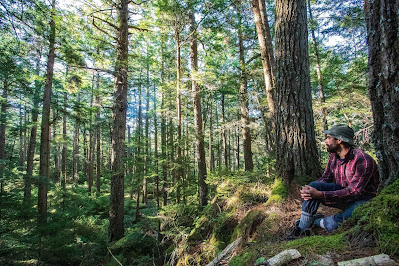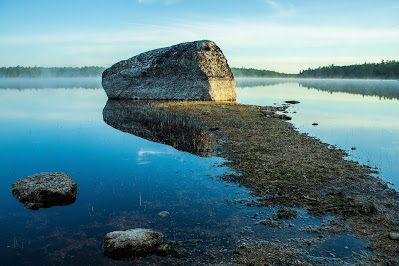Where Grows the King of Hemlocks
My Search for our Oldest Tree
By Zack Metcalfe
Many, thanks to Zack for permission to use his copy and images(s).
* * *
Our canoe was laden with all the necessities of outdoor life, and sloshing with water carried in by our socks, soaked every time we were obliged to leap overboard and carry our craft over rocks and beaver dams and the simple shallows of August.
The intense sun of afternoon scattered the clouds and laid claim to Sporting Lake ahead and around us, the easiest paddling of the day, its depths presenting few if any hazardous boulders through red tinted water.
In this lake I saw an island, drawing my eyes with supernatural sureness and speaking to a deeply spiritual segment of my rigidly rational mind.
“Is that it?” I asked to the man in the rear of our canoe, pointing.
“That’s it,” he said.
In some ways, I was doomed from the start. Finding the oldest tree in the Maritimes is a goal I set down in 2015, before the dynamic and complicated nature of our beleaguered woods was made clear to me.
None of our trees grow older than the Eastern hemlock, so it stands to reason that our oldest tree would be hiding in those hemlock groves which have dodged the destructive indiscretions of European settlement, and the unrepentant hungers of modern forestry.
Precious few still exist, typically lost in webs of regenerating clearcuts or else deep in the unroaded reaches of regional wilderness. Even if you could find such pockets of forest, the shortcomings of tree coring fast become frustrating.
When burrowing into a hemlock with the slender shaft of a coring device, it is industry standard to begin 1.3 metres up from the base, roughly chest height.
But hemlocks are patient creatures, growing slowly in the shade for as many as 50-100 years before reaching 1.3 metres tall.
So, the first century of a hemlock’s life might not be represented in a core taken 1.3 metres from the ground. What’s more, the heartwood of most hemlocks tends to decay over time.
This is an entirely natural and healthy process for the tree, but it does mean that decades, even centuries worth of rings are lost in all but a few specimens.
But even in this imperfect mess, we have discovered astounding seniority.
In 2017 I muscled through a regenerating clearcut near Coolen Lake, Lunenburg County, before stumbling into a hemlock stand as open and stupefying as the Sistine Chapel. There, researcher Colin Gray of the Mersey Tobeatic Research Institute cored a tree 422 years old (now 425), which predates European settlement.
Other hemlocks across the province have struggled into the 450 range, and about ten years ago, botanist Alain Belliveau of Acadia University cored an Eastern hemlock on North Bingay Lake Island, deep in the Tobeatic Wilderness Area, at 466 years (now 476). In all my research, this appears the oldest confirmed core in all the Maritimes. He had two witnesses.
It was Alain who shattered my dreams of finding our oldest tree.
Given the inaccuracies of coring, he said, it’s likely impossible to identify a winner. While visiting an old growth stand in Cape Breton only this July, for example, he had to core seven hemlocks before getting a readable result.
“As much as we want to focus on the age of individual trees, there’s as much to say about the age of forests themselves,” explained Alain.
In his view, the oldest tree in the Maritimes could only be found in forests which have never been logged, never been burned in their entirety, and which have not been forced to migrate by shifts in climate or ecology.
Find our oldest continuous forest, he said, and you can be fairly confident our oldest single tree is somewhere inside.
I asked which forest he would nominate, and he led me to the island at the heart of Sporting Lake.
The Sporting Lake Nature Reserve is a small, regulatory entity embedded in the much larger Tobeatic Wilderness Area in southwest Nova Scotia.
The island at its centre is a mere 20 hectares, surrounded by 300-400 metres of water on all sides and, by some miracle, spared the intense logging and fires which have so radically altered surrounding shores.
When we landed that first afternoon, I was confronted by a cathedral of hemlocks, each a tall, straight and slender pillar supporting the arboreal architecture of the canopy, arching and spreading in friendly competition for the sunlight which, in places, cut through and shocked the forest floor with reds, oranges and pinks.
When imagining old growth we are conditioned to expect the west coast, with trees as fat as they are ancient, but the Eastern hemlock is a different beast.
The oldest are quite often of everyday width, blending in with the masses and taking a cautious approach to the heavens.
There are exceptions, but truly old hemlocks are difficult to spot by size alone.
There are more subtle signs of a forest’s age which can be read by the botanist, and for us laymen, manifest as an undercurrent of awe which swells like a chorus the longer we hold still.
The heavy silence of ancient forests is unsettling, and your voice very nearly echoes.
Alain has surveyed such hemlock groves for over a decade, professionally and recreationally, and has a keen eye for their eldest trees, even without his coring device.
I found the island’s peak, atop one of its many boulders, and watched as Alain scrutinized several of these trees.
Some, he said later, were truly old, and a few, perhaps, in excess of 500 years. The forest itself, he explained, has probably persisted on this island, relatively undisturbed, for 5-6 thousand years.
“Sporting Lake is a miracle,” he said.
But there was another man moving through these woods whom I watched from my peak and later joined.
Matt Smith is the head ecologist of Kejimkujik National Park and the pilot of another canoe to strike these shores.
As we walked he grabbed the branches of young hemlocks and checked the underside of their needles, finding small, white balls of cotton consistently, a sure sign of Hemlock Woolly Adelgid (HWA).
This invasive insect was accidentally introduced to Virginia from Asia sometime in the 1950s, and has since killed many billions of hemlocks across the eastern United States.
Mortality is very nearly 100 per cent, and the insect is indiscriminate. HWA was found to have infested southern Nova Scotia in 2017, and was discovered more recently on Sporting Lake Island, threatening to do what loggers and fires and climatic change had failed to do for thousands of years - whip this sacred place clean.
Alain and Matt have both watched hemlock forests die of this affliction, destined perhaps to infest the totality of Nova Scotia, and in a mere decade, take away all of our ancient hemlocks.
Matt spoke briefly about the work underway to ready our forests for the assault of HWA, and the remedies being considered to protect special stands like that in Sporting Lake, but it’s difficult for any admirer of hemlock to remain optimistic.
“It really does pull on your heartstrings,” said Alain. “Not only is it right in your face, but you feel like you’re losing a part of yourself, too.”
You cannot camp on Sporting Lake Island, so we took to the surrounding shores dominated instead by young maples and pines, and pitched our tents under a dark sky preserve, the air clear as a bell and the Milky Way at the top of its form, shooting stars burning across its canvass and reflecting faithfully in the glassy surface of Sporting Lake.
We watched on our backs, lying on the frigid white sand of a granite beach. It was difficult not to be grateful for our place in time.
The next morning I returned to Sporting Lake Island alone.
By the golden hour light I admired these hemlocks one last time, knowing that any one of them might be the tree I’d been searching for since 2015, growing here since the 15th century, perhaps soon to expire for no good reason at all.
The chorus swelled in me again, the magic of this place playing on my biochemistry, and my mounting grief.
Maybe we will beat back HWA for a while; maybe we’ll defeat it outright; maybe we’ll create the conservation conditions necessary for trees to become this old elsewhere; maybe we won’t.
Maybe in a few years the pilgrimages to Sporting Lake, which stretch at least as far back as the written record, will end, and maybe this place will become just another island, robbed of the riches of natural history.
Paddling here was a privilege, but it was difficult to leave, knowing that if I ever came back, there may not be anything left to see.
Zack Metcalfe is a freelance journalist, columnist and author active across the Maritimes.




